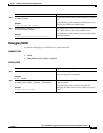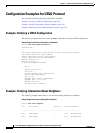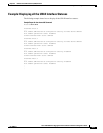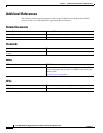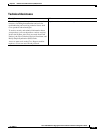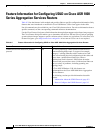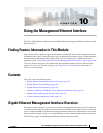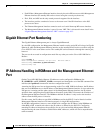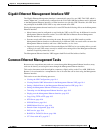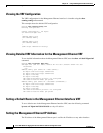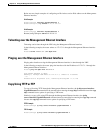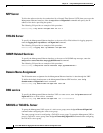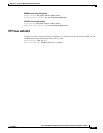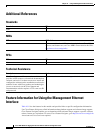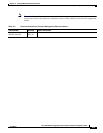
10-3
Cisco ASR 1000 Series Aggregation Services Routers Software Configuration Guide
OL-16506-15
Chapter 10 Using the Management Ethernet Interface
Gigabit Ethernet Management Interface VRF
Gigabit Ethernet Management Interface VRF
The Gigabit Ethernet Management interface is automatically part of its own VRF. This VRF, which is
named “Mgmt-intf,” is automatically configured on the Cisco ASR 1000 Series Router and is dedicated
to the Management Ethernet interface; no other interfaces can join this VRF. Therefore, this VRF does
not participate in the MPLS VPN VRF or any other network-wide VRF.
Placing the management ethernet interface in its own VRF has the following effects on the Management
Ethernet interface:
• Many features must be configured or used inside the VRF, so the CLI may be different for certain
Management Ethernet functions on the Cisco ASR 1000 Series Routers than on Management
Ethernet interfaces on other routers.
• Prevents transit traffic from traversing the router. Because all of the SPA interfaces and the
Management Ethernet interface are automatically in different VRFs, no transit traffic can enter the
Management Ethernet interface and leave a SPA interface, or vice versa.
• Improved security of the interface. Because the Mgmt-intf VRF has its own routing table as a result
of being in its own VRF, routes can only be added to the routing table of the Management Ethernet
interface if explicitly entered by a user.
The Management Ethernet interface VRF supports both IPv4 and IPv6 address families.
Common Ethernet Management Tasks
Because users can perform most tasks on a router through the Management Ethernet interface, many
tasks can be done by accessing the router through the Management Ethernet interface.
This section documents tasks that might be common or slightly tricky on the Cisco ASR 1000 Series
Routers. It is not intended as a comprehensive list of all tasks that can be done using the Management
Ethernet interface.
This section covers the following processes:
• Viewing the VRF Configuration, page 10-4
• Viewing Detailed VRF Information for the Management Ethernet VRF, page 10-4
• Setting a Default Route in the Management Ethernet Interface VRF, page 10-4
• Setting the Management Ethernet IP Address, page 10-4
• Telnetting over the Management Ethernet Interface, page 10-5
• Pinging over the Management Ethernet Interface, page 10-5
• Copy Using TFTP or FTP, page 10-5
• NTP Server, page 10-6
• SYSLOG Server, page 10-6
• SNMP-Related Services, page 10-6
• Domain Name Assignment, page 10-6
• DNS service, page 10-6
• RADIUS or TACACS+ Server, page 10-6
• VTY lines with ACL, page 10-7



